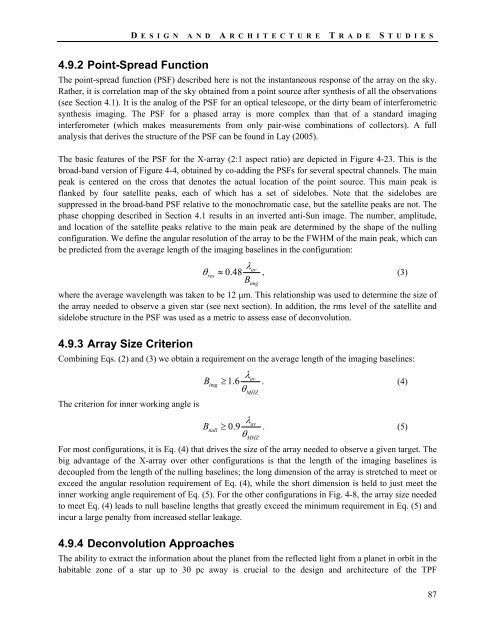TPF-I SWG Report - Exoplanet Exploration Program - NASA
TPF-I SWG Report - Exoplanet Exploration Program - NASA
TPF-I SWG Report - Exoplanet Exploration Program - NASA
You also want an ePaper? Increase the reach of your titles
YUMPU automatically turns print PDFs into web optimized ePapers that Google loves.
D ESIGN AND A R C H I T E C T U R E T RADE S TUDIES<br />
4.9.2 Point-Spread Function<br />
The point-spread function (PSF) described here is not the instantaneous response of the array on the sky.<br />
Rather, it is correlation map of the sky obtained from a point source after synthesis of all the observations<br />
(see Section 4.1). It is the analog of the PSF for an optical telescope, or the dirty beam of interferometric<br />
synthesis imaging. The PSF for a phased array is more complex than that of a standard imaging<br />
interferometer (which makes measurements from only pair-wise combinations of collectors). A full<br />
analysis that derives the structure of the PSF can be found in Lay (2005).<br />
The basic features of the PSF for the X-array (2:1 aspect ratio) are depicted in Figure 4-23. This is the<br />
broad-band version of Figure 4-4, obtained by co-adding the PSFs for several spectral channels. The main<br />
peak is centered on the cross that denotes the actual location of the point source. This main peak is<br />
flanked by four satellite peaks, each of which has a set of sidelobes. Note that the sidelobes are<br />
suppressed in the broad-band PSF relative to the monochromatic case, but the satellite peaks are not. The<br />
phase chopping described in Section 4.1 results in an inverted anti-Sun image. The number, amplitude,<br />
and location of the satellite peaks relative to the main peak are determined by the shape of the nulling<br />
configuration. We define the angular resolution of the array to be the FWHM of the main peak, which can<br />
be predicted from the average length of the imaging baselines in the configuration:<br />
λ<br />
θ ≈ 0.48 av , (3)<br />
res<br />
B img<br />
where the average wavelength was taken to be 12 μm. This relationship was used to determine the size of<br />
the array needed to observe a given star (see next section). In addition, the rms level of the satellite and<br />
sidelobe structure in the PSF was used as a metric to assess ease of deconvolution.<br />
4.9.3 Array Size Criterion<br />
Combining Eqs. (2) and (3) we obtain a requirement on the average length of the imaging baselines:<br />
λav<br />
Bimg<br />
≥ 1.6 . (4)<br />
θMHZ<br />
The criterion for inner working angle is<br />
λav<br />
Bnull<br />
≥ 0.9 . (5)<br />
θMHZ<br />
For most configurations, it is Eq. (4) that drives the size of the array needed to observe a given target. The<br />
big advantage of the X-array over other configurations is that the length of the imaging baselines is<br />
decoupled from the length of the nulling baselines; the long dimension of the array is stretched to meet or<br />
exceed the angular resolution requirement of Eq. (4), while the short dimension is held to just meet the<br />
inner working angle requirement of Eq. (5). For the other configurations in Fig. 4-8, the array size needed<br />
to meet Eq. (4) leads to null baseline lengths that greatly exceed the minimum requirement in Eq. (5) and<br />
incur a large penalty from increased stellar leakage.<br />
4.9.4 Deconvolution Approaches<br />
The ability to extract the information about the planet from the reflected light from a planet in orbit in the<br />
habitable zone of a star up to 30 pc away is crucial to the design and architecture of the <strong>TPF</strong><br />
87
















